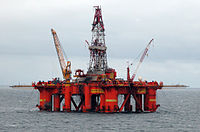
Photo from wikipedia
The vortex-induced motion (VIM) is a critical issue in mooring and riser system design for column-type deepwater platforms. As regards to deep-draft semi-submersibles (DDS), even though VIM is mainly excited… Click to show full abstract
The vortex-induced motion (VIM) is a critical issue in mooring and riser system design for column-type deepwater platforms. As regards to deep-draft semi-submersibles (DDS), even though VIM is mainly excited by vortex shedding around columns, the large-volume pontoons beneath the columns are also responsible for the wake interference, implying a non-negligible influence on VIM behavior. An experimental study and three-dimensional numerical simulations were performed to analyze the pontoon effect on the VIM of two semi-submersibles and a four-column structure without pontoons. The numerical results using Detached Eddy Simulation (DES) are in good agreement with the experimental measurements obtained from the towing model tests. The present investigations indicate that the resonant phenomenon is observed for all configurations. However, the four-column structure without pontoons shows the most significant transverse responses and yaw motions at both 0°- and 45°-incidences owing to the largest fluctuating lift forces induced by the well-established wake. Additionally, the negative values of work done by the pontoons at all reduced velocities confirm their damping effect on the VIM response.
Journal Title: Journal of Fluids and Structures
Year Published: 2017
Link to full text (if available)
Share on Social Media: Sign Up to like & get
recommendations!